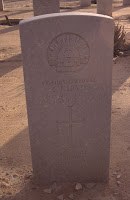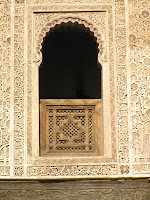Yesterday I got to see my home town, Rabat, through the eyes of tourists, as I showed around a group of visitors here for a conference. First stop was Tour Hassan, often the only stop for tour groups as it was when I visited Morocco in 2000.
Tour Hass

an, or Tower of Hassan is the 44-metre high uncompleted mosque minaret begun in the late 1100s. Even though it is nearly 20 metres short of the desired height, the details of its intricate carving can still be clearly seen today, 800 years later. Good views over the Rabat medina and kasbah, the BouRegreg river and the more traditional town of Sale on the other side can be had from the nearby viewpoints. The large courtyard in front of the minaret is dotted by the remains of the pillars from the unfinished mosque that was destroyed in 1755 by the earthquake that also destroyed Lisbon. Although home to pigeons today, the earthen walls still circle the complex but are starting to show signs of wear and tear in places.
At the opposite end of the courtyard to the minaret is the Mausoleum of Mohammed V, in which the p

resent king's father, Hassan II and grandfather, Mohammed V are buri

ed. Located on one of the highest points in Rabat, the mausoleum is an example of exquisite craftmenship both inside and out. Inside the walls are covered in geometric tiled mosaics (zellij) made of individual tiny tiles that fit together perfectly, intricately carved wood and more than a splash of gold. It is an awe-inspiring place in which one can't help but feel reverence. Surrounding it are more examples of the craftmanship such as carved wooden doors and zellij fountains.
After lots of "ohs and ahs" and many photographs, it was off to the Kasbah Oudaias via the enormous decorated gate. Wandering through the narrow

alleys bordered by white-washed houses trimmed in sky blue, we stopped at the Galerie d'Art Nouiga where there was a colourful display of Moroccan photographs. With no vehicles, steps worn down in the centre through repeated use, arched gates, and the blooming red geraniums, it is a pleasant walk and photographer's delight. Cafe Maure provided an ideal place to stop for a drink and a chat. It used to have wonderful views across the river to Sale until the developers moved in. Supposedly it will be an upmarket complex of hotel, shops and a marina in a few years. But I liked watching the small wooden boats criss-crossing the river. Adjoining the cafe are the Andulusian gardens, a peaceful oasis from the sometimes frenetic traffic outside. With roses, hibiscus and orange trees amongst the residents, it is a riot of colour at many times of the year.
Final stop was the medina for some last minute shopping. Rabat's medina is a very gentle introduction for first-time visitors to Rabat as the vendors are not at all pushy. In fact, on some occ

asions you have to wait around for them to arrive and give you a price. Not everyone will reduce their prices through bargaining, but if buying carpets, it is must. Besides carpets, the medina is a great place to buy silver jewelry (sold per 100 mg), lamps both metal and painted goat skin, wood products, leather goods including shoes and bedspreads and cushion covers. Rue de Consul, which during the French Protectorate was home to many consulates, is the centre of the tourist shopping medina. Head further afield and you find the local area of the medina with stalls selling clothing, dried fruit and nuts, olives, kitchenware, fruit and a less-than-appealing selection of butcher off-cuts such as sheep's heads and hooves!
To complete the Moroccan experience, evening saw us back in the medina to sample Moroccan food at Dinarjat, a restaurant found behind a tall, feature-less wall, after wending our way in through the narrow alleys. Set in a restored riad, there was the opportunity to sample the traditional Moroccan dishes such as pastilla, tagine and couscous. Even though I have lived in Rabat a while, it was the first time I had been to this restaurant and would have no hesitation in recommending it as an excellent place to try traditional Moroccan food in a very pleasant environment.
 It was not until the bus pulled up at the front gate that I suddenly had the thought that my great uncle was buried here. My mother often spoke of Uncle Cec, of how he was like an older brother, how he taught her to knit as a child. So back and forth I went through line after line of headstones wondering how a war could be fought on the barren desert plains of northern Egypt. After an hours searching, I found it.
It was not until the bus pulled up at the front gate that I suddenly had the thought that my great uncle was buried here. My mother often spoke of Uncle Cec, of how he was like an older brother, how he taught her to knit as a child. So back and forth I went through line after line of headstones wondering how a war could be fought on the barren desert plains of northern Egypt. After an hours searching, I found it.









